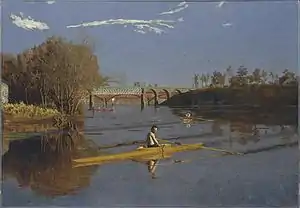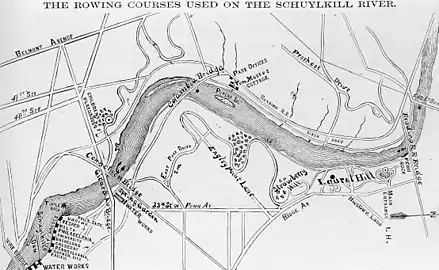Pennsylvania Railroad, Connecting Railway Bridge | |
|---|---|
.jpg.webp) Pennsylvania Railroad, Connecting Railway Bridge from the southeast in 1999. | |
| Coordinates | 39°58′35″N 75°11′38″W / 39.97639°N 75.19389°W |
| Carries | SEPTA Trenton Line and Chestnut Hill West Line, Amtrak Northeast Corridor, NJT Atlantic City Line |
| Crosses | Girard Avenue, Schuylkill River, Landsdowne Drive |
| Locale | Philadelphia, Pennsylvania |
| Other name(s) | Pennsylvania Railroad, New York Division, Bridge No. 69 |
| Characteristics | |
| Design | Arch bridge |
| Material | Stone |
| Longest span | 103 feet (31 m) |
| History | |
| Designer | John A. Wilson (attributed) George Brooke Roberts |
| Constructed by | Thomas Seabrook |
| Opened | 1867 |
| Location | |
Pennsylvania Railroad, Connecting Railway Bridge is a stone arch bridge in Philadelphia, Pennsylvania, that carries Amtrak Northeast Corridor rail lines and SEPTA and NJT commuter rail lines over the Schuylkill River. It is located in Fairmount Park, just upstream from the Girard Avenue Bridge.
It is also known as Pennsylvania Railroad, New York Division, Bridge No. 69. Other names include Connecting Railway Bridge, Connection Bridge, New York Connecting Bridge, New York Railroad Bridge, and Junction Railroad Bridge.
Initial bridge
The bridge was built in 1866 and 1867 by the Connecting Railway, a company affiliated with the Pennsylvania Railroad and formally purchased by the PRR in 1871. Its purpose was to connect the PRR's southern and northern lines, and to be part of an eventual direct PRR line from Washington, D.C., to New York City. Before the bridge's construction, PRR trains took a circuitous route between PRR's West Philadelphia and North Philadelphia Stations.
The bridge was probably designed by John A. Wilson, chief engineer of the Connecting Railway Company, who surveyed the route in 1863. Following Wilson's 1864 resignation, PRR First Vice-President George Brooke Roberts, an engineer, took over the project and saw it through to completion. (He later became president of the PRR.) Thomas Seabrook was the masonry contractor.
The bridge opened to traffic on 2 June 1867.[1] The bridge was narrow, with only 2 tracks and an iron truss at mid-river. This was a 236-foot-3-inch (72 m) cast- and wrought-iron, arch-reinforced, double-intersection Whipple truss.
In 1873, PRR slightly reduced the truss's span by widening the stone piers at each end. Probably at the same time, PRR removed the truss's reinforcing arch. In 1897, PRR replaced the Whipple truss with a Pratt truss of the same length.[2]
Expanded bridge
Between 1912 and 1915, PRR more than doubled the width of the bridge to 5 tracks, and replaced the mid-river iron truss with two massive stone arches.[3] Alexander C. Shand was the designer of what was essentially a new bridge, built to look like the original. Eyre, Shoemaker, Inc. was the masonry contractor. Reiter, Curtis & Hill built the reinforced concrete bridges over Lansdowne Drive and West Girard Avenue, and the viaduct curving around the Philadelphia Zoo.[4]
In art
The Connecting Railway Bridge, with its line of stone arches, was a frequent subject for painters. It appears in works by Carl Philipp Weber,[5] Edmund Darch Lewis, Thomas Moran, and, most famously, Max Schmitt in a Single Scull (1871) by Thomas Eakins.
 Max Schmitt in a Single Scull (1871) by Thomas Eakins.
Max Schmitt in a Single Scull (1871) by Thomas Eakins. A View of Philadelphia from Belmont Plateau (1873) by Edmund Darch Lewis.
A View of Philadelphia from Belmont Plateau (1873) by Edmund Darch Lewis._p718_PHILADELPHIA%252C_PENNSYLVANIA_RAILROAD_BRIDGES.jpg.webp) 1891 engraving by Moses King.
1891 engraving by Moses King.
Other images
 1872 Schuylkill River map.
1872 Schuylkill River map..jpg.webp) Connecting Railway Bridge (circa 1867-73) with original reinforced-arch truss.
Connecting Railway Bridge (circa 1867-73) with original reinforced-arch truss. Connecting Railway Bridge (circa 1867-73) from the south.
Connecting Railway Bridge (circa 1867-73) from the south. East River Drive (circa 1873) approaching the Connecting Railway Bridge.
East River Drive (circa 1873) approaching the Connecting Railway Bridge. East River Drive going under the Connecting Railway Bridge.
East River Drive going under the Connecting Railway Bridge..jpg.webp) Connecting Railway Bridge (after 1873) with reinforced-arch removed from truss.
Connecting Railway Bridge (after 1873) with reinforced-arch removed from truss. Spring Garden Pumping Station (after 1873) with the Connecting Railway Bridge in the background.
Spring Garden Pumping Station (after 1873) with the Connecting Railway Bridge in the background..jpg.webp) Colorized photograph of the East River Drive (circa 1900).
Colorized photograph of the East River Drive (circa 1900). Aerial view of the Philadelphia Zoo (2003). The Pennsylvania Railroad, Connecting Railway Bridge is at bottom.
Aerial view of the Philadelphia Zoo (2003). The Pennsylvania Railroad, Connecting Railway Bridge is at bottom.
See also
References
- ↑ Spivey, Justin (April 2001). "Connecting Railway, Schuylkill River Bridge" (PDF). Historic American Engineering Record. Washington, D.C.: Library of Congress. pp. 5–6. Retrieved May 27, 2020.
- ↑ Richards, Joseph T. (April 1898). "Replacement of the Old Metal-Span of the Pennsylvania Railroad Bridge over the Schuylkill River at Philadelphia, October 17, 1897". Proceedings of the Engineers' Club of Philadelphia. 14 (4): 302–309.
- ↑ Solomon, Brian (2008). Railroads of Pennsylvania. St. Paul: MBI Publishing Company and Voyageur Press. p. 70. ISBN 978-0-7603-3245-0.
- ↑ Spivey, pp. 6-7.
- ↑ Beth Kephart, Flow: The Life and Times of Philadelphia's Schuylkill River (2007), p. 101.
Further reading
- Schotter, Howard W. (1927). The Growth and Development of the Pennsylvania Railroad Company ... 1846 to 1926. Philadelphia: Press of Allen, Lane, and Scott.
External links
- Historic American Engineering Record (HAER) No. PA-37, "Connecting Railway, Schuylkill River Bridge"
- Historic American Buildings Survey (HABS) No. PA-6213, "Pennsylvania Railroad, Mantua Junction Viaduct", 2 photos by Jack Boucher, 1995.